FoodInSpector: Inline-capable sensor technology for inspection of packaged foods

FoodInSpector is able to scan food and check a series of parameters. Fraunhofer FHR
Fraunhofer FHR and its partner Fraunhofer IOSB will present the “FoodInSpector” sensor system designed for the quality control of food. FoodInSpector uses millimetre waves to scan products and detect contamination as well as deviations in the production process. The technology is capable of inspecting frozen products, baked goods, and hollow as well as filled products.
Millimetre wave sensors take their measurements based not only on the attenuation of the signal during the scan but also on the changes of the signal’s transit time caused by inclusions. Combined with an automatic image analysis process, the resulting system is able to reliably scan packaged goods for contaminants and detect deviations in homogenous production processes.
Furthermore, thanks to the ability to measure residual moisture, the system is particularly well suited for the monitoring of drying processes. Unlike x-ray technology, the processes can be applied directly without any additional radiation protection measures. They can also provide a stronger contrast ratio, particularly for plastic contaminants.
Up to now, the most common technique for product inspections in the food industry besides x-ray are optical systems such as hyperspectral cameras. For the most part, these systems only capture measurement readings on product surfaces. By combining them with high frequency sensors, it is possible to examine packaged goods and detect contaminations inside products.
Fraunhofer IOSB and FHR will demonstrate such a sensor system at the Anuga FoodTec using chocolate bars as an example. The process can be adapted to the most diverse products to deliver optimized customer-specific results, being especially suitable for dried and frozen food. System development is focused on the the ability to integrate these sensors into existing plants.
As one of Europe’s leading institutes, the Fraunhofer Institute for High Frequency Physics and Radar Techniques FHR conducts extensive research in the area of high frequency and radar technology. Its core research focuses on sensors for precise distance regulation and positioning as well as imaging systems. The applications range from systems for reconnaissance, surveillance, and protection to real-time capable sensors for traffic and navigation as well as quality assurance and non-destructive testing.
The Fraunhofer Institute of Optronics, System Technologies and Image Exploitation IOSB studies and develops multi-sensor systems and software that support humans in their perception of and their interactions with the environment. This ranges from the generation and automatic analysis of aerial and satellite images, e.g. of a disaster area, all the way to the sorting and quality inspection of bulk goods such as coffee beans or minerals.
Contact:
Hanne Bendel
Internal and external communication
Fraunhofer Institute for High Frequency Physics and Radar Techniques FHR
Fraunhoferstraße 20 | 53343 Wachtberg
Phone +49 (0)151 646 33 712 | Fax -627
mailto:hanne.bendel@fhr.fraunhofer.de
https://www.fhr.fraunhofer.de/en/press-media/press-releases/foodinspector_anugaf…
http://www.fhr.fraunhofer.de
Media Contact
All latest news from the category: Information Technology
Here you can find a summary of innovations in the fields of information and data processing and up-to-date developments on IT equipment and hardware.
This area covers topics such as IT services, IT architectures, IT management and telecommunications.
Newest articles

Properties of new materials for microchips
… can now be measured well. Reseachers of Delft University of Technology demonstrated measuring performance properties of ultrathin silicon membranes. Making ever smaller and more powerful chips requires new ultrathin…

Floating solar’s potential
… to support sustainable development by addressing climate, water, and energy goals holistically. A new study published this week in Nature Energy raises the potential for floating solar photovoltaics (FPV)…

Skyrmions move at record speeds
… a step towards the computing of the future. An international research team led by scientists from the CNRS1 has discovered that the magnetic nanobubbles2 known as skyrmions can be…





















